Ivanka Trump, it has been reported, may assume some duties customarily assigned to First Ladies. As a business associate and campaign adviser, the eldest Trump daughter is already being called “the most powerful First Lady ever” by the Washington Post. Reportedly, Ivanka will work from an “office of the First Family” in the East Wing, the traditional site of the office of the most powerful woman in Washington.
This would not be the first instance of a First Lady ceding some of her duties to someone who isn’t a presidential spouse. As far back as the post-revolutionary years, among the absentee First Ladies were those who could plead illness, mourning, or death as an excuse for not fulfilling what former First Lady Pat Nixon called “the hardest unpaid job in the world.”
Thomas Jefferson (1801–1809): Daughter Patsy Jefferson Randolph
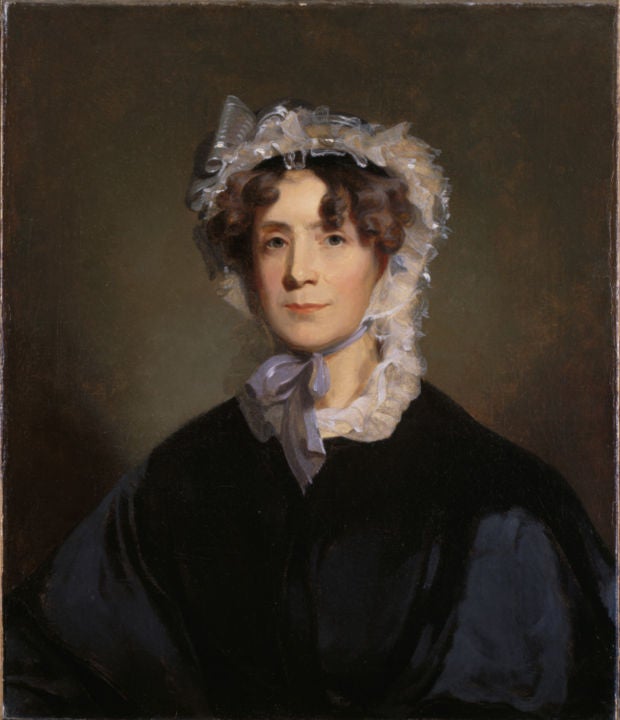
Thomas Jefferson’s wife, Martha Wayles Skelton Jefferson, died years before he became president, so daughter Patsy Jefferson Randolph and Dolley Madison (who would be the nation’s next First Lady, though the term wasn’t popularized until the mid-nineteenth century) acted as hostesses. Jefferson, however, mostly preferred to keep women out of politics and more often invited just men to dine.
Andrew Jackson (1829–1837): Niece Emily Donelson
Rachel Donelson Robards Jackson never made it to the White House. The “American Jezebel” was said to have never divorced her previous husband (whom she married in her late teens), making her marriage to Jackson bigamy. (It was an honest mistake—she had left him and heard that he had filed a petition for divorce.)
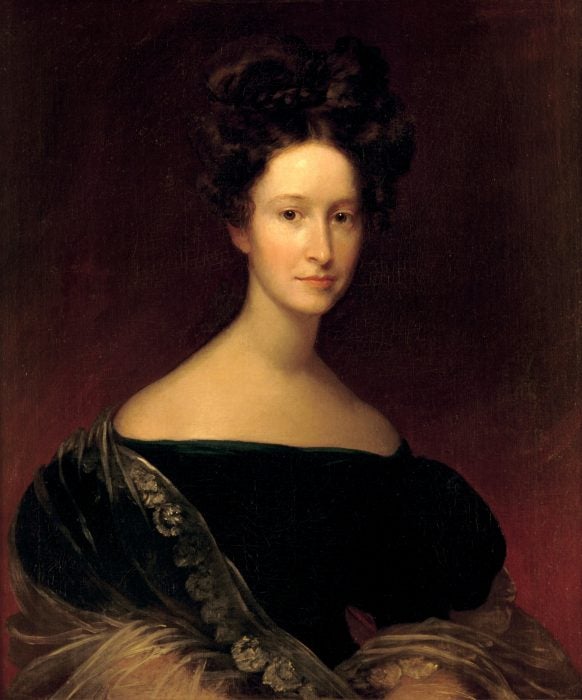
On a trip to Nashville to buy an inauguration wardrobe, she was shocked to read a pamphlet describing her in extremely unflattering terms (a “profligate woman” and “convicted adulteress”). She supposedly never recovered, dying two months before her husband took office (he blamed her death on his political enemies). Perhaps it was for the best, as she had supposedly told a friend, “I would rather be a doorkeeper in the house of God than live in that palace in Washington.”
Hosting duties were given to Rachel’s niece Emily Donelson, who took over at the age of 21. She was praised for her wonderful tact, and for her bravery in disagreeing with the President on issues of principle. She died of tuberculosis in 1836. For the last months of the administration, hostess duties were assumed by Sarah Yorke Jackson, wife of Andrew Jackson, Jr. (a nephew Rachel and the president had adopted).
Martin Van Buren (1837–1841): Daughter-in-Law Angelica Singleton
Hannah Hoes Van Buren died before the age of 36, most likely of tuberculosis, in 1819, well before her husband’s time in office. The childhood sweethearts grew up in a small Dutch community in New York. Their eldest son, Abraham, met Angelica Singleton, a South Carolina belle visiting her cousin Dolley Madison. The two fell in love and quickly married. Angelica then took over hosting duties for her father-in-law.
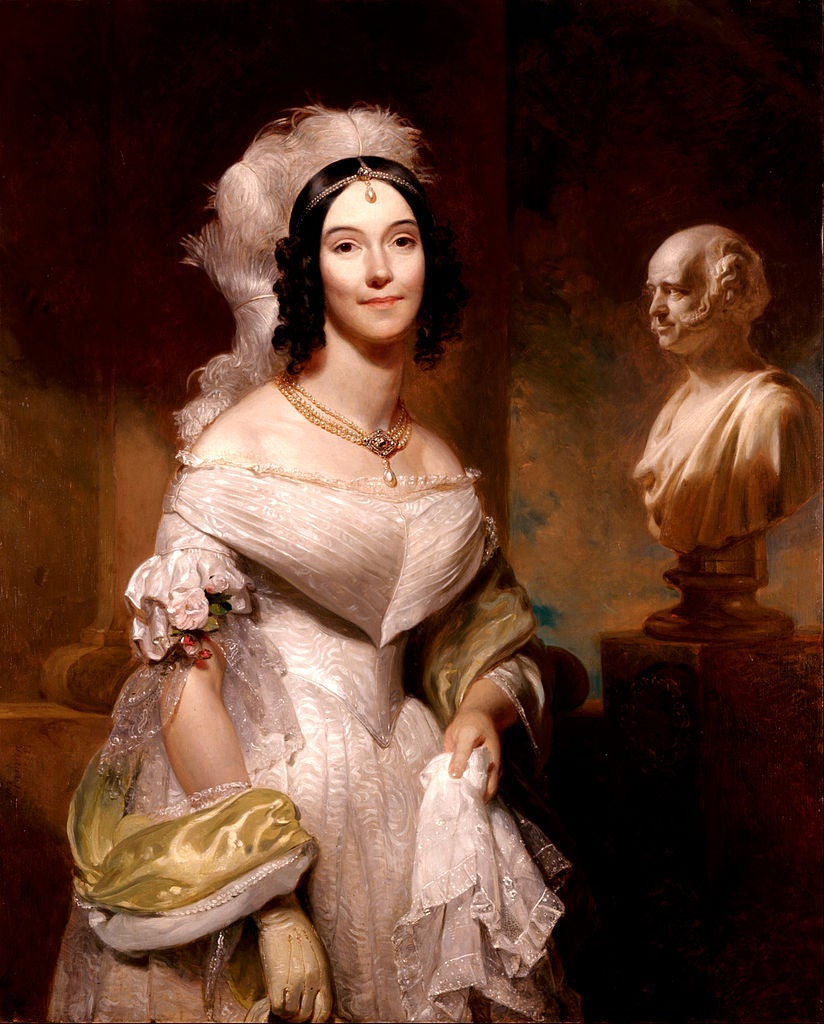
Singleton’s portrait, with dark corkscrew curls and ostrich plumes, said to be Jackie Kennedy’s favorite, hung in the Red Room. Inspired by honeymoon visits with European aristocrats, Angelica spent her 1840 New Year’s Day reception sitting silently, “tableaux” style, holding a bouquet of flowers so that she could avoid the expected handshakes. Some historians think that press accounts of this royal behavior and her upper-class, finishing-school background helped lose Van Buren a second term.
John Tyler (1841–1845): Daughter-in-Law Priscilla Cooper Tyler
Born on a Virginia plantation, Letitia Christian Tyler had been partially paralyzed by a stroke for two years when her husband suddenly became President. During his years as a Congressman and Governor of Virginia, she joined him only once for the Washington social season. She spent her year as First Lady in her room, before dying of another stroke, becoming the first First Lady to die in the White House.
Her daughter-in-law Priscilla Cooper Tyler called her “the most entirely unselfish person you can imagine.…Notwithstanding her very delicate health, Mother attends to and regulates all the household affairs and all so quietly that you can’t tell when she does it.” At age 24, Priscilla assumed duties as official First Lady until Tyler’s next marriage.
Charles Dickens, whom she hosted at a huge reception, called Priscilla “very interesting, graceful, and accomplished.” Her father was a famed tragedian, and Priscilla had been an actress since age 17. When playing Desdemona (from Othello) in Richmond, she met her wealthy husband. With her theatrical experience, she was described as extroverted, attractive, and witty. (She was one of only three First Ladies with acting experience. Pat and Richard Nixon met as cast members of a drama group, and Nancy Reagan was a Hollywood starlet.)
Of her hostess duties, she complained, “Such hearty shakes as they gave my poor little hand too!” At one of the first parties thrown by the president, he met socialite Julia Gardiner Tyler. Thirty years younger than the president, the 24-year-old senator’s daughter recalled being chased around the tables at the party where they met. She married him, and served as First Lady from 1844 to 1845.
Zachary Taylor (1849–1850): Daughter Mary Elizabeth Taylor Bliss
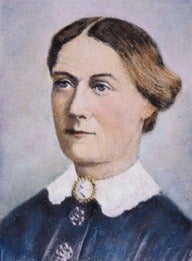
The daughter of a wealthy planter, Margaret “Peggy” Mackall Smith Taylor was treated as a semi-invalid. She received visitors in her upstairs sitting room at the White House, but wouldn’t attend state functions, having promised God she would give up fashionable society if her husband were spared in the war. He was; she did. She handed over hosting duties to daughter Mary Elizabeth Taylor Bliss, 25, known as Miss Betty, who was recently married to the president’s secretary and was said to combine “the artlessness of a rustic belle and the grace of a duchess.”
Millard Fillmore (1850–1853): Daughter Mary Abigail Fillmore
Abigail Powers Fillmore was the first First Lady to have a job after marriage. She and the future president met when he was her student; she was 21, and he was 19. In 1849, she came to D.C. as wife of the vice president. She was suffering from ill health by the time her husband succeeded President Taylor. An injured ankle made standing by her husband’s side at Friday-night “levees” (receptions) an ordeal, so she handed over many of her duties to daughter Mary Abigail Fillmore, known as Abby. Abigail (the elder) caught a cold standing by her husband’s side on a blustery, snowy day at the next president’s inauguration (Franklin Pierce). She died of pneumonia soon after.
Franklin Pierce (1853–1857): Wife’s friends Abigail Kent Means and Varina Howell Davis
Jane Means Appleton Pierce supposedly fainted at the news that her husband had been chosen as presidential candidate by the Democratic Party. Her son Bennie wrote her about this news: “I hope he won’t be elected for I should not like to be at Washington and I know you would not either.” Bennie died on January 6, 1853, in a horrible train wreck, before Jane’s very eyes.
The inauguration took place on March 4 without an inaugural ball and without Jane, who joined her husband later that month. She was said never to have recovered from her loss, and spent her time in the White House in mourning. (Already-famous author Nathaniel Hawthorne even referred to her as “that death’s head” in the White House.) She felt Bennie’s life was taken in retribution for his father’s involvement in politics.
Jane’s childhood friend (and aunt by marriage) Abigail Kent Means assisted the First Lady with social obligations. Jane’s friend Varina Howell Davis, wife of War Secretary Jefferson Davis, also fulfilled hosting duties. Varina (Mrs. Jefferson) Davis perhaps found that experience useful in the future, as First Lady of the Confederacy.
James Buchanan (1857–1861): Niece Harriet “Hal” Lane
The bachelor president had no First Lady. Instead, his 26-year-old orphan niece Harriet “Hal” Lane (daughter of a younger sister, Jane) served as his hostess. In 1841, he became Harriet’s official guardian. She was known as a flirty beauty with masses of golden hair and violet eyes, educated at boarding schools and a Georgetown convent. Accompanying her uncle, she impressed Queen Victoria on a visit to London with her deft curtsy. The monarch called her “dear Miss Lane.”
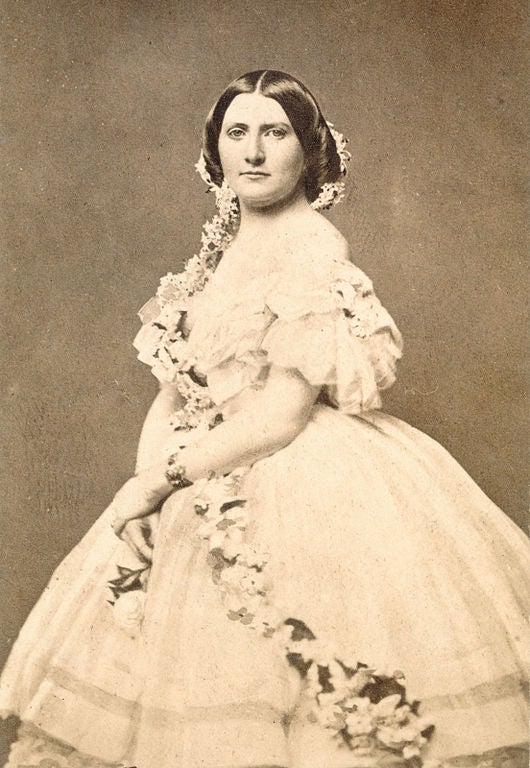
Harriet was plunged into mourning due to the death of her brother shortly after the inauguration, which pressed pause on formal entertaining. Following the death, she organized state dinners and negotiated protocol—though her uncle publicly criticized her for a badly cooked ham, saying it reflected poor governance of the kitchen staff. The president required her to refuse all gifts from foreign powers, of which she said, “Think of my feelings when the lovely lacquered boxes and tables the Japanese Embassy brought me were turned from the door, to say nothing of the music boxes and these fascinating sewing machines they had just invented.” She was known for her deeply plunging lace “bertha” collars. She was the first to be referred to as “First Lady in the land” in public print. Harriet placed the signature furniture in what became the Blue Room.
Andrew Johnson (1865–1869): Daughter Martha Johnson Patterson
“I do not like this public life at all,” wrote Eliza McCardle Johnson, whose husband was Vice President before Lincoln’s assassination. She added: “I often wish the time would come when we could return to where I feel we best belong,” which was, apparently, not 1600 Pennsylvania Avenue. Eliza was the first (and one of few) First Ladies born in poverty. An invalid possibly suffering from tuberculosis, Eliza didn’t attend her husband’s inauguration as Abraham Lincoln’s VP, remaining in Nashville. After the assassination, her daughter wrote to now-president Johnson: “Poor mother, she is almost deranged fearing that you will be assassinated.”
Eliza was not the complete recluse she’s been called, though she restricted her official duties to visits by foreign heads of state and formal dinners. Her daughter Martha Johnson Patterson acted as unpretentious-yet-deft hostess at large public receptions, with the help of her younger sister Mary Johnson Stover. Martha would put on a calico apron and milk the White House cows every morning. She told a reporter: “If I could only walk about a little with my children sometimes in the grounds without being stared at, and really enjoy the comfort of an old dress and a little privacy it would be very pleasant.”
Chester Arthury (1881–1885): Sister Mary “Molly” Arthur McElroy
Ellen Lewis Herndon Arthur died suddenly of pneumonia eight months before her husband took office upon the death of his predecessor, President James Garfield. The daughter of a naval officer and a talented singer, Ellen was considered striking—slim with pale skin and dark hair and eyes (magnified by gutta-percha spectacles, to help her nearsightedness). The grieving president, the fourth to enter the White House as a widower, wouldn’t put anyone in his late wife’s place.
After a period of mourning for Garfield’s death and much speculation over who would be Arthur’s fill-in First Lady, he asked his sister, Mary “Molly” Arthur McElroy. Press reports say that the president didn’t make any final decisions about White House entertaining without Molly, whom they called “lively” and “self-possessed.” Another article called her “very retiring in her looks, and without ambition for public recognition.”
Grover Cleveland (1885–1889, 1893–1897): Sister Rose Elizabeth “Libbie” Cleveland
For nearly two years before he married Frances “Frank” Folsom, 21, who had been under his care since the death of her father when she was nine, the bachelor President’s hostess was his sister, Rose Elizabeth “Libbie” Cleveland. This was the first time First Lady duties were handed from one presidential sister to another. A writer, editor, and teacher, Rose was considered something of a “bluestocking,” and revealed that she whiled away the tedious hours in reception lines by mentally conjugating Greek and Latin verbs. One of her last efforts as First Lady was to plan her brother’s wedding to Frances, who would become the first First Lady to be married in the White House and the youngest First Lady.
Benjamin Harrison (1889–1893): Daughter Mary Harrison McKee
Benjamin Harrison’s wife Caroline Lavinia Scott Harrison was the first president of the Daughters of the American Revolution. She organized the presidential china collection, offering china-painting classes to anyone interested, and ordered renovations to the White House. Caroline died at the White House in 1892 of tuberculosis at the age of 60. After a period of mourning, her daughter Mary Harrison McKee fulfilled hostess duties for the last part of her father’s term.
Woodrow Wilson (1913–1921): Daughter Margaret Wilson
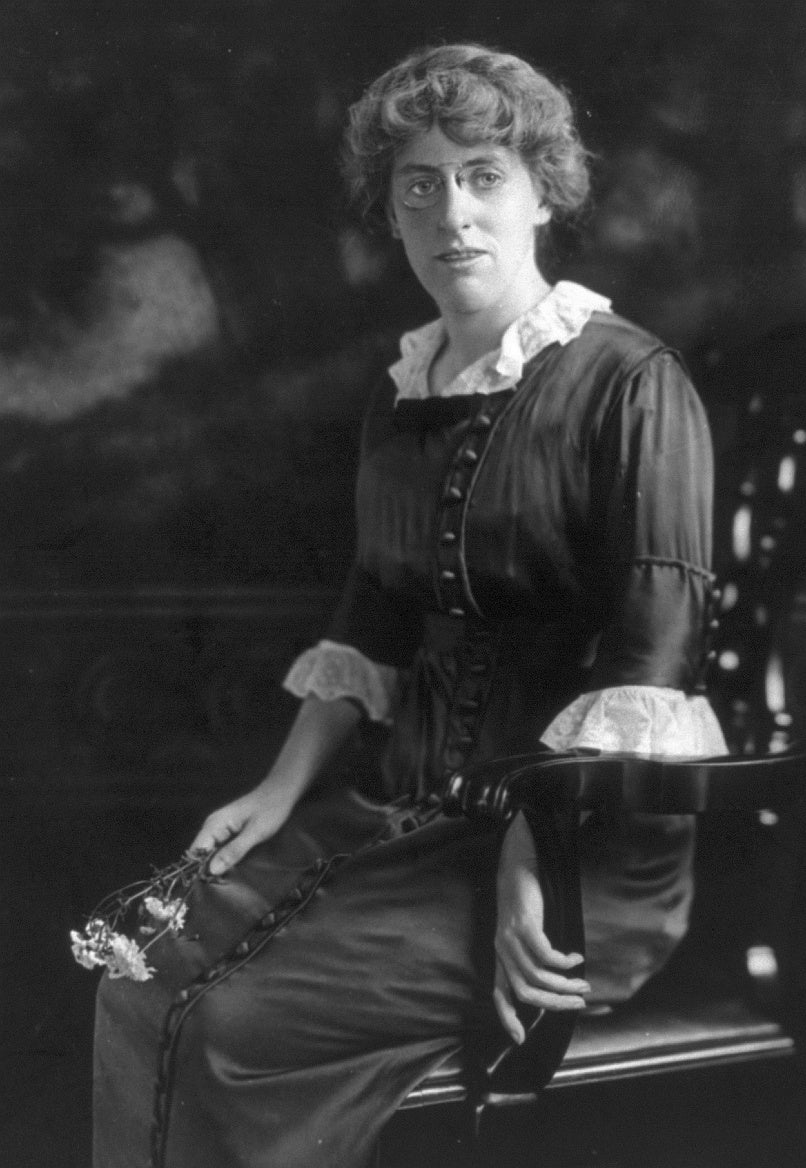
Ellen Louise Axson Wilson wrote to the departing President Taft that, “I am naturally the most unambitious of women, and life in the White House has no attractions for me.”
In failing health due to Bright’s disease, she died in August 1914 after less than a year in the White House. One of her accomplishments was establishing the White House Rose Garden. She wrote, “Nobody who has not tried can have the least idea of the exactions of life here and of the constant nervous strain of it all.”
Margaret Wilson, Woodrow’s only unmarried daughter, served as de facto First Lady after her mother’s death. She continued some duties after her father married Edith Bolling Galt Wilson in 1915.
The author wishes to acknowledge her reliance on the excellent research resources at firstladies.org and whitehouse.gov.







